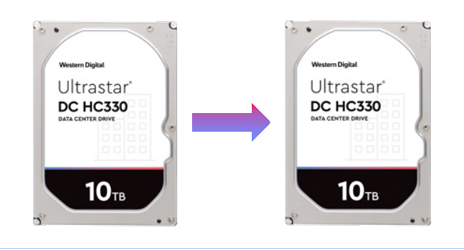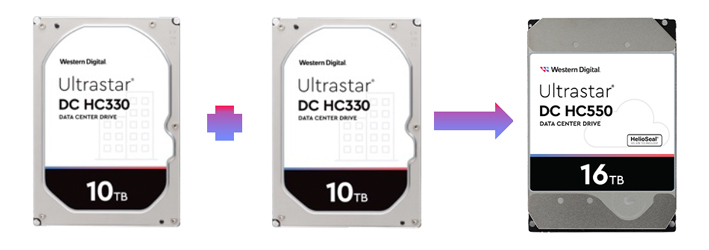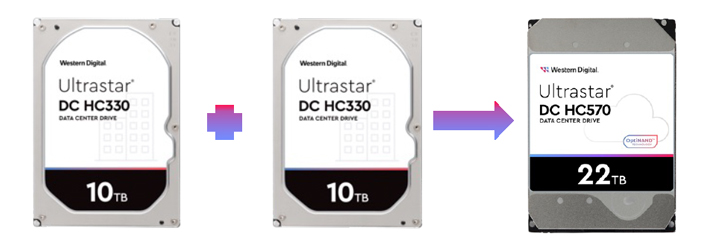
Konsolidacija kapaciteta za smanjenje ukupnih troškova
Diskovi od 22TB pružaju maksimalnu gustinu skladištenja
Kada dođe vreme za obnavljanje diskova, idealno je vreme da pregledate gustinu svog storidža kako biste osigurali da je vaša investicija optimizovana za dugoročnu upotrebu i iskoristila prednosti petogodišnje garancije2. Pogledajmo neke od ključnih scenarija za obnavljanje:
Direktna zamena - najgori slučaj |  |
Povećanje kapaciteta - kratkoročno niska ROI |  |
Optimizovana gustina skladištenja - smanjenje TCO na dugi rok |  |
Ključni faktori uštede troškova
Ušteda energije ![]()
Pokretanje jednog diska u jedinici za regal umesto 2 manja diska u 2 jedinice za regal donosi značajne uštede u potrošnji energije i troškovima hlađenja. Sam disk pruža do 64%* uštede energije sa 450KWh* ušteđenih tokom 5 godina (SATA Power - 50/50 R/W @40 IOPS, na IDLE_0).
Smanjenje prostora za regale ![]()
Svaka jedinica za regal ima trošak nabavke, postavljanja i rada. Dupliranje gustine skladištenja omogućava vam ili smanjenje potreba za regalima za polovinu ili udvostručavanje efektivnog skladištenja uz isti operativni trošak. Do 55% manje diskova smanjuje prostor za regale do 50%.
Potrebne su Vam dodatne informacije?
Obratite se svom ASBIS komercijalisti i povežite se sa našim stručnim tehničkim timom kako biste pronašli najbolje rešenje za vas.
1. 1GB=1.000.000.000 bajtova i 1TB=1.000.000.000.000 bajtova. Stvarni kapacitet može biti manji u zavisnosti od radnog okruženja.
2. Period ograničene garancije ili maksimalnog kapaciteta izdržljivosti (TBW), zavisno o tome šta se prvo desi. Pogledajte support.wdc.com/warranty za regionalne detalje o garanciji.
Western Digital, Western Digital dizajn, Western Digital logo i Ultrastar su registrovani zaštitni znakovi ili zaštitni znakovi Western Digital Corporation ili njenih filijala u SAD-u i/ili drugim zemljama. Sva ostala obeležja su vlasništvo njihovih odgovarajućih vlasnika. Specifikacije proizvoda podložne su promenama bez prethodne najave. Prikazane slike mogu se razlikovati od stvarnih proizvoda. © 2023 Western Digital Corporation ili njene filijale. Sva prava zadržana.
